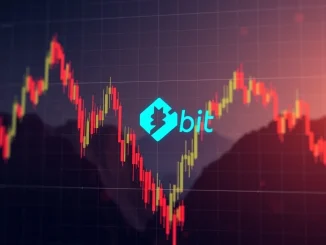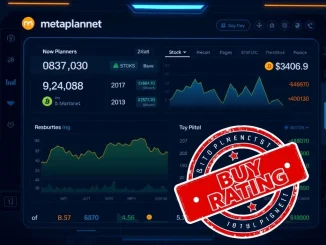
In the fast-paced world of cryptocurrency trading, volatility is a constant companion. One critical metric traders and analysts watch closely is **crypto liquidation**. This data provides a snapshot of market sentiment and the impact of price swings on highly leveraged positions, particularly in the **perpetual futures** market.
Understanding Crypto Liquidation in Perpetual Futures
What exactly is a **crypto liquidation**? When trading perpetual futures, traders can use leverage, borrowing funds to open positions larger than their initial capital. While this amplifies potential profits, it also magnifies risk. If the market moves against a leveraged position to a certain point (the liquidation price), the exchange automatically closes the position to prevent the trader’s balance from falling below zero. This forced closure is a liquidation.
Perpetual futures are a type of futures contract that doesn’t have an expiry date, allowing traders to hold positions indefinitely as long as they meet margin requirements. They are incredibly popular but also inherently risky due to leverage. Monitoring liquidation data helps gauge where leveraged bets were concentrated and which side (long or short) faced the most pressure.
The Latest 24-Hour Crypto Liquidation Breakdown
Over the past 24 hours, significant **crypto liquidation** volume was recorded across major assets in the perpetual futures market. Here’s a look at the key figures:
- BTC Liquidation: $34.24 million liquidated. A notable 56.64% of this volume consisted of Short positions.
- ETH Liquidation: $23.33 million liquidated. Here, Long positions dominated, accounting for 60.48%.
- XRP Liquidation: $8.04 million liquidated. Long positions were overwhelmingly hit, making up 86.16%.
The total liquidation volume across these three assets alone exceeded $65 million, a significant sum reflecting recent market movements.
What Do These Liquidation Numbers Tell Us?
Analyzing the direction of liquidations (long vs. short) offers insights into market sentiment and the prevailing leveraged bets before the price moved.
For **BTC liquidation**, the higher percentage of short liquidations suggests that Bitcoin saw upward price movement that squeezed traders betting on a price decline using leverage. When the price rose, these short positions became unprofitable and were forcibly closed.
Conversely, the data for **ETH liquidation** and **XRP liquidation** shows a clear dominance of long liquidations. This indicates that both Ethereum and XRP experienced price drops that hit traders who were using leverage to bet on rising prices. Their leveraged long positions were wiped out as prices fell.
The high percentage of long liquidations for XRP is particularly striking, highlighting the sensitivity of leveraged XRP positions to downward price volatility during this period.
Why is Monitoring Liquidation Data Important?
Tracking **perpetual futures** liquidations is crucial for several reasons:
- Market Sentiment Indicator: Dominant liquidation direction (long or short) can indicate whether recent price action primarily punished bullish or bearish leveraged traders.
- Volatility Gauge: High liquidation volumes often accompany significant price swings, confirming periods of heightened volatility.
- Potential Fuel for Price Moves: Mass liquidations can sometimes exacerbate price movements. For example, large long liquidations involve forced selling, which can push prices down further.
- Risk Awareness: Seeing large liquidation figures serves as a stark reminder of the risks associated with high-leverage trading.
Actionable Insights for Traders
Given the data on **crypto liquidation**, what can traders take away?
- Manage Leverage Wisely: The millions liquidated daily underscore the danger of excessive leverage. Use it cautiously or avoid it altogether, especially during volatile periods.
- Use Stop-Loss Orders: Protect your positions by setting stop-loss orders to automatically exit a trade if the price moves against you, preventing a full liquidation.
- Understand Market Structure: Recognize that liquidation levels can sometimes act as magnets or catalysts for price moves as large orders are executed.
- Diversify Risk: Don’t over-concentrate risk in highly leveraged positions on a single asset.
Observing **BTC liquidation**, **ETH liquidation**, and **XRP liquidation** helps traders stay informed about market dynamics and the potential pitfalls of leveraged trading.
The Challenges of Trading Perpetual Futures
While **perpetual futures** offer opportunities for profit in both rising and falling markets, the challenges are significant. The primary challenge is managing the risk of liquidation, especially with high leverage. Funding rates, which are periodic payments between long and short traders, can also add to costs. Furthermore, rapid, unexpected price swings (often called ‘wicking’) can trigger liquidations even if the price quickly recovers.
Conclusion: A Snapshot of Market Pain
The past 24 hours saw over $65 million in **crypto liquidation** across Bitcoin, Ethereum, and XRP perpetual futures. This data isn’t just a number; it represents forced closures of leveraged positions, primarily short bets on BTC and long bets on ETH and XRP. It serves as a powerful illustration of the inherent risks in leveraged trading and the swift, unforgiving nature of the **perpetual futures** market. Traders must approach this market with caution, disciplined risk management, and a clear understanding of how liquidations occur to navigate the volatility successfully.



